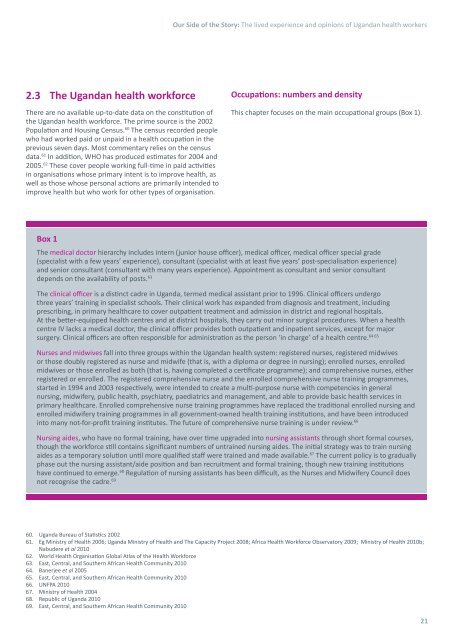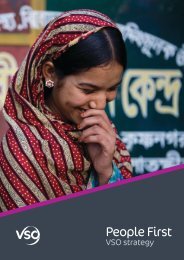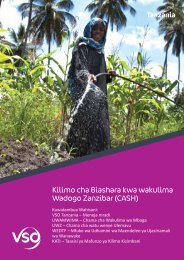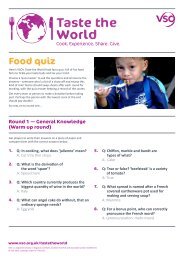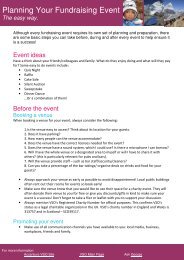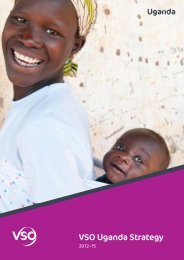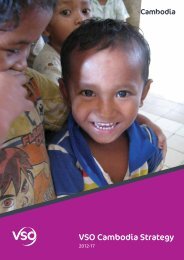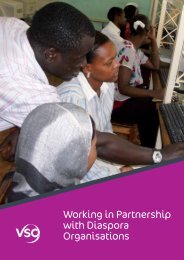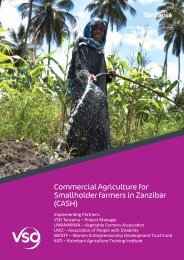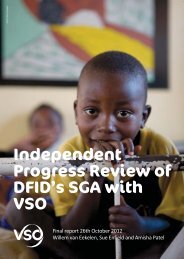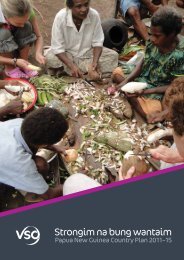Our Side of the Story - VSO
Our Side of the Story - VSO
Our Side of the Story - VSO
- No tags were found...
You also want an ePaper? Increase the reach of your titles
YUMPU automatically turns print PDFs into web optimized ePapers that Google loves.
<strong>Our</strong> <strong>Side</strong> <strong>of</strong> <strong>the</strong> <strong>Story</strong>: The lived experience and opinions <strong>of</strong> Ugandan health workers2.3 The Ugandan health workforceThere are no available up-to-date data on <strong>the</strong> constitution <strong>of</strong><strong>the</strong> Ugandan health workforce. The prime source is <strong>the</strong> 2002Population and Housing Census. 60 The census recorded peoplewho had worked paid or unpaid in a health occupation in <strong>the</strong>previous seven days. Most commentary relies on <strong>the</strong> censusdata. 61 In addition, WHO has produced estimates for 2004 and2005. 62 These cover people working full-time in paid activitiesin organisations whose primary intent is to improve health, aswell as those whose personal actions are primarily intended toimprove health but who work for o<strong>the</strong>r types <strong>of</strong> organisation.Occupations: numbers and densityThis chapter focuses on <strong>the</strong> main occupational groups (Box 1).Box 1The medical doctor hierarchy includes intern (junior house <strong>of</strong>ficer), medical <strong>of</strong>ficer, medical <strong>of</strong>ficer special grade(specialist with a few years’ experience), consultant (specialist with at least five years’ post-specialisation experience)and senior consultant (consultant with many years experience). Appointment as consultant and senior consultantdepends on <strong>the</strong> availability <strong>of</strong> posts. 63The clinical <strong>of</strong>ficer is a distinct cadre in Uganda, termed medical assistant prior to 1996. Clinical <strong>of</strong>ficers undergothree years’ training in specialist schools. Their clinical work has expanded from diagnosis and treatment, includingprescribing, in primary healthcare to cover outpatient treatment and admission in district and regional hospitals.At <strong>the</strong> better-equipped health centres and at district hospitals, <strong>the</strong>y carry out minor surgical procedures. When a healthcentre IV lacks a medical doctor, <strong>the</strong> clinical <strong>of</strong>ficer provides both outpatient and inpatient services, except for major64 65surgery. Clinical <strong>of</strong>ficers are <strong>of</strong>ten responsible for administration as <strong>the</strong> person ‘in charge’ <strong>of</strong> a health centre.Nurses and midwives fall into three groups within <strong>the</strong> Ugandan health system: registered nurses, registered midwivesor those doubly registered as nurse and midwife (that is, with a diploma or degree in nursing); enrolled nurses, enrolledmidwives or those enrolled as both (that is, having completed a certificate programme); and comprehensive nurses, ei<strong>the</strong>rregistered or enrolled. The registered comprehensive nurse and <strong>the</strong> enrolled comprehensive nurse training programmes,started in 1994 and 2003 respectively, were intended to create a multi-purpose nurse with competencies in generalnursing, midwifery, public health, psychiatry, paediatrics and management, and able to provide basic health services inprimary healthcare. Enrolled comprehensive nurse training programmes have replaced <strong>the</strong> traditional enrolled nursing andenrolled midwifery training programmes in all government-owned health training institutions, and have been introducedinto many not-for-pr<strong>of</strong>it training institutes. The future <strong>of</strong> comprehensive nurse training is under review. 66Nursing aides, who have no formal training, have over time upgraded into nursing assistants through short formal courses,though <strong>the</strong> workforce still contains significant numbers <strong>of</strong> untrained nursing aides. The initial strategy was to train nursingaides as a temporary solution until more qualified staff were trained and made available. 67 The current policy is to graduallyphase out <strong>the</strong> nursing assistant/aide position and ban recruitment and formal training, though new training institutionshave continued to emerge. 68 Regulation <strong>of</strong> nursing assistants has been difficult, as <strong>the</strong> Nurses and Midwifery Council doesnot recognise <strong>the</strong> cadre. 6960. Uganda Bureau <strong>of</strong> Statistics 200261. Eg Ministry <strong>of</strong> Health 2006; Uganda Ministry <strong>of</strong> Health and The Capacity Project 2008; Africa Health Workforce Observatory 2009; Ministry <strong>of</strong> Health 2010b;Nabudere et al 201062. World Health Organisation Global Atlas <strong>of</strong> <strong>the</strong> Health Workforce63. East, Central, and Sou<strong>the</strong>rn African Health Community 201064. Banerjee et al 200565. East, Central, and Sou<strong>the</strong>rn African Health Community 201066. UNFPA 201067. Ministry <strong>of</strong> Health 200468. Republic <strong>of</strong> Uganda 201069. East, Central, and Sou<strong>the</strong>rn African Health Community 201021


